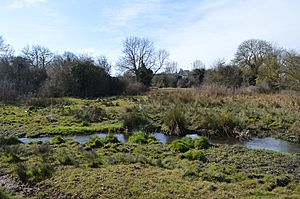River Purwell facts for kids
The River Purwell is a special kind of river called a chalk stream. It flows through Hertfordshire, England. This whole river is found close to the town of Hitchin. Chalk streams are rare and important. They get their water from springs that bubble up through chalk rock.
Contents
Where the River Purwell Starts and Flows
The River Purwell begins from springs. These springs rise out of chalk rock near a place called St Ippolyts. At first, this water forms a small stream known as Ippollitts Brook.
As the water flows, it becomes known as the Purwell. This happens when it reaches an area called Ninesprings. Ninesprings is located between the areas of Great Wymondley and Hitchin. The river then continues its journey. Finally, it joins another river, the River Hiz.
Protecting the River and Its Wildlife
The River Purwell and the wet areas around it are very important. These wet areas are called wetlands. They are home to many different plants and animals. To keep them safe, parts of the river are protected.
These protected areas are called nature reserves. You can find these nature reserves at Ninesprings and Purwell Meadows. They help make sure the river's natural beauty and wildlife can thrive.
The History of Purwell Mill
For many years, the River Purwell helped power a watermill. This mill was located at Purwell Meadows. A watermill uses the force of flowing water to turn a wheel. This wheel then powers machinery, often for grinding grain into flour.
The mill at Purwell Meadows worked until the 1920s. The building you see there today is a few hundred years old. However, there has been a mill at this spot for a very long time. It was even mentioned in a famous old book.
The Domesday Book and the Mill
The mill was written about in the Domesday Book. This important document was created in 1086. It was a huge survey ordered by King William. The Domesday Book recorded details about land and property across England.
The book noted that the mill was worth 20 shillings. Shillings were a type of money used in England a long time ago. This part of the mill belonged to King William. Because the mill stretched over the river, it was partly in a different area called Hitchin manor. So, the owners of Great Wymondley had to pay a small yearly fee of 6 pence. Pence were another old type of English money.


